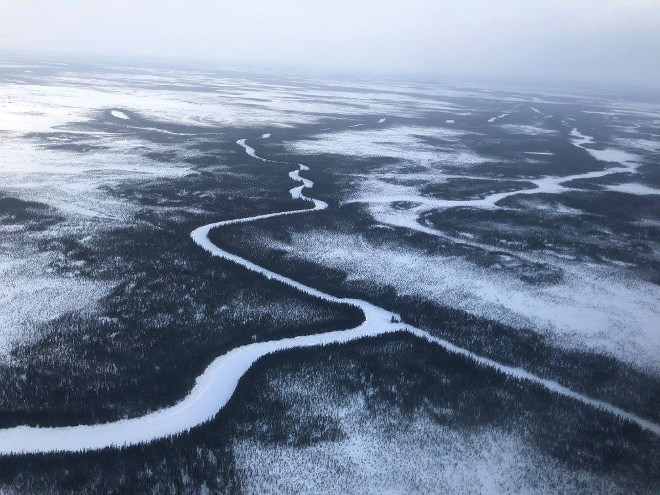A coalition of conservationists, environmentalists and lawyers want Ottawa's Ring of Fire environmental assessment process to be broadened in size and scope to include industrial centres like Sault Ste. Marie and Sudbury.
In a March 15 letter sent to three federal cabinet ministers, the group is calling for a pause in the two-year-old Regional Assessment process in order to rejig the structure and governance to allow Indigenous communities in the region to take the lead.
It's the same proposal put forward earlier by an alliance of remote First Nation communities in the James Bay area.
The correspondence was sent to Steven Guilbeault, Canada's environment and climate change minister; Jonathan Wilkinson, the natural resources minister, and Marc Miller, the minister of Crown-Indigenous Relations.
Some of the signatories to the letter include representatives from the Wildlands League, MiningWatch Canada, Greenpeace Canada, The David Suzuki Foundation, and World Wildlife Fund-Canada.
From what they've viewed in the draft agreement, released by Impact Assessment Agency and spelling out the ground rules, the group answered that this method disregards treaty rights, disrespects traditional Indigenous knowledge, and "betrays" the promise to engage and work alongside First Nations people.
Also signatories to the letter were the Coalition for a Liveable Sudbury, the Wilderness Committee, Northwatch, Clean North, Canadian Environmental Law Association, Ontario Nature and the National Audubon Society.
In February 2020, Ottawa and then-Environment and Climate Change Minister Jonathan Wilkinson decided to apply this new out-of-the-box approach to the Ring of Fire to study the impacts of potential mining and mining-related activity in the Far North.
The feds felt this was a better way than doing a series of one-off individual project assessments on what may turn out to be a district-scale series of mines, similar in size to the Sudbury Basin. The government first tried this approach two years ago to examine the impacts of offshore oil and gas exploratory drilling, east of Newfoundland.
To get feedback, the Impact Assessment Agency turned to communities in the Ring of Fire area, the public, and various stakeholders for input on the scope of this study in drafting the terms of reference. Online comments closed Feb. 1.
In their letter to Ottawa, the group said they initially welcomed the regional approach, but what they see shaping up is a narrowly focussed one that places an emphasis on studying the impact of mining on the landscape.
The kind of comprehensive assessment they want to see would examine the broader global implications of "massive industrial activity" on significant wetlands and watersheds of the greater Hudson Bay area.
"A proposed new mining district, approximately five times the size of the City of Toronto, should not treated as fait accompli in this day and age," the letter said.
Disturbance of this undeveloped area, they claim, would result in the release millions of tons of greenhouse gases stored in "one of the most carbon-rich ecosystems on the planet."
The group wants the study area opened up to include entire northern watersheds; namely the Ekwan, Attawapiskat and Winisk systems; the ecosystems of the region's peatlands, wetlands and boreal forest, and want the scope expanded to include "all human activities" and the various factors that influence climate change.
On the mining front, the group said this assessment must address the "social and environmental consequences" of the industry's extraction, transportation and processing aspects, which means noting the concerns of residents in Sault Ste. Marie and Sudbury where Ring of Fire ore would be processed.
The group added Ottawa needs to restore public trust with a credible process, make good on its legal commitment to the United Nations Declaration on the Rights of Indigenous Peoples, and follow through on its obligations to climate change.
"Canada may not be able to afford the carbon costs of full mining exploitation in the Ring of Fire given its location in one of the most carbon-rich ecosystems on the planet," the letter said.
Two First Nations near the area of the Ring of Fire, Marten Falls and Webequie, are largely supportive of development. The communities are on the proposed route into the mineral camp and are steering the provincial environmental assessment processes.
They have stayed mostly low key and out of the lengthy regional debate, but Webequie recently piped up and issued a statement to the federal government of their staunch opposition against any reset of the assessment.
The Ring of Fire is a crescent-shape string of mining claims are in the remote lowlands of the James Bay region more than 500 kilometres northeast of Thunder Bay.
Though much-talked about since the first decade of this century, to date, no mines have been built and an access road network to the region is still in the provincial environmental assessment stage.
The earliest a mine could come into production is late 2027 when Noront Resources' underground Eagle's Nest nickel and copper mine is tentatively slated to begin commercial operation.
Wyloo Metals, a major mining interest from Australia, is expected to take formally control of Noront's nickel, chromite and base metal properties early next month.




